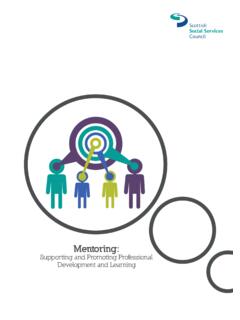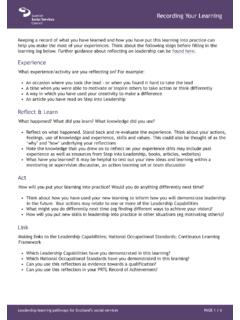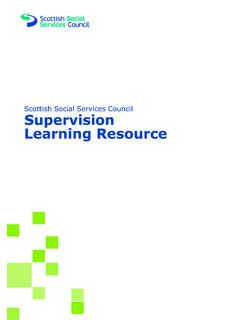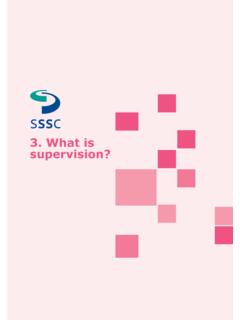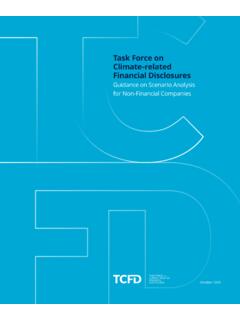Transcription of GUIDANCE FOR MENTORING IN CHILDHOOD PRACTICE
1 GUIDANCE for MENTORING in CHILDHOOD practiceGUIDANCE FOR MENTORING IN CHILDHOOD PRACTICECCUOThe Coalition of CHILDHOOD Umbrella OrganisationsGuidance for MENTORING in CHILDHOOD PRACTICE The Coalition of CHILDHOOD Umbrella Organisations 2010 Designed and published by: Communications, Care CommissionAcknowledgementThe Coalition of CHILDHOOD Umbrella Organisations (CCUO) wishes to thank the Scottish Government and parent organisations of the CCUO membership, programme learners, mentees and colleagues within the University of Edinburgh. Thanks are also due to the Scottish Social Services Council (SSSC) and the CHILDHOOD PRACTICE Development Group (CPDG) for their ongoing advice and support. Also to Jennie Paul, Independent Consultant, for her help, support and advice during the early phase of the development of the for MENTORING in CHILDHOOD practiceCONTENTSF oreward Minister 1 The Coalition of CHILDHOOD Umbrella Organisations (CCUO) 21.
2 Who is this GUIDANCE for? 32. How can the guidelines be used? 7 3. Who is this GUIDANCE for? 84. What are the benefits of MENTORING ? 95. Why adopt a formal approach to MENTORING ? 116. Key ingredients for successful MENTORING frameworks 127. Designing a framework 138.
3 Coordinating a MENTORING programme 149. Training, induction and raising awareness 15 10. Criteria for selecting of mentors and mentees 1711. Matching mentors and mentees 1812. The MENTORING process and the relationship cycle 19 13. What is the purpose of the first meeting? 2014. Monitoring and evaluation 21 References 23 Terms we have used and what they mean 24 The MENTORING toolkitThis section contains good PRACTICE information, activities and templates which can be adapted to suit the specific requirements of individual employers and can also find good PRACTICE advice and templates by contacting the Scottish MENTORING Association, the International MENTORING Association and other toolkit 25A.
4 What makes a good mentor? 26B. Self assessment planning tool 27C. MENTORING framework template 31D. Characteristics of successful mentees 35 E. Flow chart for recruiting and selecting mentors and mentees 36F. Sample MENTORING agreement form 37G. A working model of the MENTORING process 38 GUIDANCE for MENTORING in CHILDHOOD practiceH. The relationship cycle 40I. Action planning and goal setting 42J. Action plan template 43K. Optimum conditions for effective adult learning 44L. Issues to consider when planning the meetings 45M. Meeting log template 46N. Case study: mentor log, CCUO pilot 2010 47O. Monitoring progress: what to check for 51 Appendix1. CCUO Membership 52 GUIDANCE for MENTORING in CHILDHOOD practiceFOREWORD Having a confident, competent and valued workforce that can deliver excellent services for children and families in Scotland now and in the future, is essential.
5 I want services to be dynamic, operating within learning organisations, with people who continuously develop their PRACTICE and deliver effective, early intervention to ensure improved outcomes for children. This requires managers with professional skills, knowledge and understanding of working with children in these, their most formative years, and strong leadership skills. That is why we are asking all managers in day care of children services to extend their learning to SCQF level 9 in CHILDHOOD PRACTICE . I am pleased to note that many lead practitioners and managers across children s services have risen to the challenge. Some have already graduated with their BA in CHILDHOOD PRACTICE . Many more are enrolled on courses across the country, demonstrating their commitment and passion and I am immensely proud of our children s workforce. We must make best use of the knowledge, skills and understanding being gained by the workforce and create a workplace that actively encourages leadership to flourish and to support people to continuously learn and develop.
6 Effective MENTORING can maximise the success of managers embarking on CHILDHOOD PRACTICE learning. It can also support and encourage managers to lead and improve PRACTICE in their workplace. That is why the Scottish Government supported the development of this MENTORING in CHILDHOOD PRACTICE GUIDANCE . It has been created by the sector, for the sector and I am pleased that it can now be am confident this GUIDANCE will help employers and managers develop MENTORING programmes that maximise the skills of our workforce and develop services that ensure children in Scotland get the best possible start in life. Adam Ingram MPMinister for Children and Young People1 GUIDANCE for MENTORING in CHILDHOOD practice2 COALITION OF CHILDHOOD UMBRELLA ORGANISATIONS Following the launch of the CHILDHOOD PRACTICE Standard (December 2007) the Scottish Social Services Council (SSSC) set up the CHILDHOOD PRACTICE Development Group (CPDG) to promote and encourage the development of CHILDHOOD PRACTICE level 9 awards and to ensure pathways to awards are flexible and accessible to learners and employers in the of the CPDG working groups draws together the breadth and range of professional expertise found in CHILDHOOD PRACTICE and includes representatives from Scotland s learning institutions, national registration, inspection and advisory agencies and voluntary, private and public sector early years and childcare employers and umbrella organisations In line with the Scottish Government s Guidelines for Providers, their Partners and Learners enrolled on the programmes (2008), early years and childcare umbrella organisations identified an additional challenge to both employers and employees working in community based (often smaller) CHILDHOOD services.
7 In these centres, it is recognised that access to appropriate support can be difficult to source which may create barriers to learning, the uptake of qualifications and to leadership development within the workforce. To address this issue, a sub group drawn from the CPDG membership and representing the voluntary and private sector umbrella agencies was established as the Coalition of CHILDHOOD Umbrella Organisations (CCUO). Its priority was to: Establish nationally recognised MENTORING GUIDANCE as an aid for employers and the umbrella organisations which support staff enrolled on programmes of learning leading to a CHILDHOOD PRACTICE Award, through all its levels. In partnership with University of Edinburgh 12 learners, each holding a leadership role within their respective area of expertise and representing all of the partners within the CCUO, undertook a bespoke level 10 course on MENTORING in CHILDHOOD PRACTICE . The outcomes of this learning and evaluation of their experiences have informed and shaped the GUIDANCE MENTORING in CHILDHOOD PRACTICE (2010).
8 GUIDANCE for MENTORING in CHILDHOOD practice1. WHO IS THIS GUIDANCE FOR?This GUIDANCE is designed to be adapted by employers, managers and staff who work in CHILDHOOD PRACTICE and the wider social services. It is based on proven, research-based good PRACTICE and its aim is to promote good PRACTICE in MENTORING programmes. The MENTORING model is not a one size fits all proposition: each organisation and the staff who work within it are different. However, there are elements which are common to all successful programmes. This GUIDANCE focuses on these common elements to help those developing and implementing MENTORING programmes to achieve their goals at all stages of the GUIDANCE is designed to help an organisation s programme to reach its potential and in turn help to support the continuous professional development of its MENTORING ?The CHILDHOOD PRACTICE workforce is currently undergoing significant transformation driven by a number of key national policies and demanding initiatives which aim to promote best outcomes for children and families.
9 The early years and CHILDHOOD services sector is expected to develop the potential and increase the capacity of staff through a continual learning process. This complements the supportive work of the Continuous Learning Framework (CLF), a Scottish Social Services Council publication which helps social service organisations, including those in CHILDHOOD PRACTICE , to support the workforce to be the best they can major policy documents driving this transformation include: The Standard for CHILDHOOD PRACTICE (2007) The Early Years Framework (2008) The Curriculum for Excellence (CfE) (2005) Pre-birth to Three Years: Positive Outcomes for Scotland s Children (2010) getting It Right for Every Child (GIRFEC) (2007)Formal MENTORING is a dynamic and effective tool for supporting such change and for enhancing professional learning and development. With a focus on self-directed learning, MENTORING offers individually tailored solutions to develop a more skilled, competent, confident and well-qualified workforce.
10 Organisations lacking the capacity, resources or the necessary skills to create an in-house MENTORING scheme could consider partnership with other CHILDHOOD PRACTICE organisations, national organisations, small community groups, networks or peer groups. Here are some examples of for MENTORING in CHILDHOOD practiceShared Partnership Model Example of an organisational partnership modelSPPACALANDNAI dentify need for mentoringprogrammes in their organisationsfeedback and evaluative reportsreach formal agreementMENTORINGCONSORTIUM feedback on MENTORING relationships within specified parametersReports toConsortiumCreates potential for buy in and building capacity in futureCommunicates to CHILDHOOD PRACTICE sector and other stakeholders in social services sectorJointly agrees purpose and aims to establish agreed MENTORING frameworkIdentifies potential mentors and mentees across their organisationsManages programme and allocates resourcesAppoints a Programme Co-ordinatormanagesresourcesundertakes associated adminprovides documentationrecruits, trains, matches and supportsmentors menteesmentoring relationshipsestablishedMonitors andevaluatesConfident.
